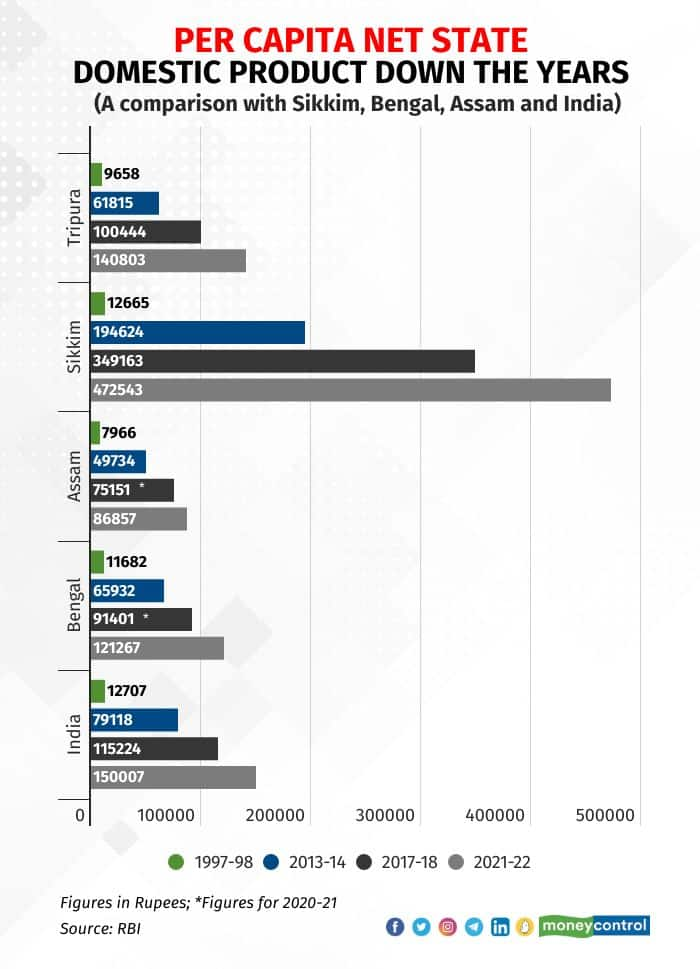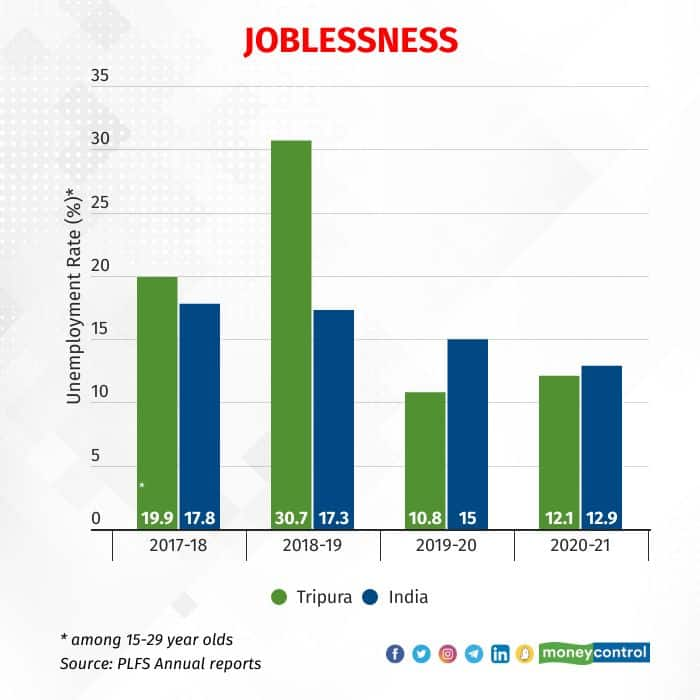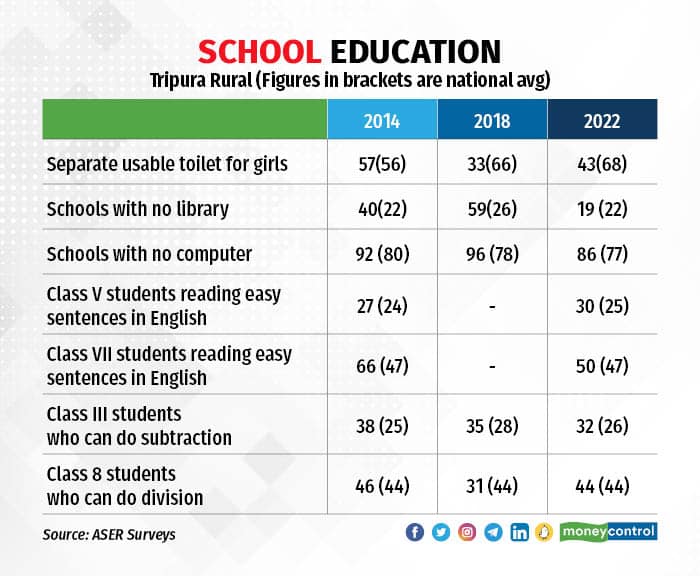



The 2018 assembly elections in Tripura was billed as a fight to the finish between the Bharatiya Janata Party (BJP) and the Communist Party of India (Marxist), which had governed the state for 25 years by winning five successive assembly elections since 1993. CPM could also boast of a credible face in Manik Sarkar, the incumbent four-term chief minister whose spartan lifestyle and spotless political career had made him one of India’s most respected politicians.
But in the end, BJP’s alliance with tribal party Indigenous People's Front of Tripura (IPFT) and the complete collapse of the Congress vote (37 per cent in 2013 to 1.8 per cent in 2018) averted a split in the anti-CPM vote. BJP sneaked ahead with a 1.4 percentage point edge over CPM and the combined BJP+IPFT voteshare outstripped the Left by six percentage points.

Source: Election Commission
The 2019 Lok Sabha elections saw BJP pull further away from the Opposition, riding on the Modi wave. Interestingly, Congress had a mini revival of sorts, hogging more voteshare (26 per cent) than the CPM (17 per cent). Ultimately, this Congress performance may be the reason for both opposition parties to forget past enmity and build bridges.

Source: Election Commission
Cut to 2023, those watching Tripura politics predict that the Tipra Motha ascendancy in the tribal heartland will undercut the gains made by BJP and IPFT in 2018, when they won 18 of the 20 ST reserved seats. The big question is whether Congress votes will transfer to the CPM. In 2018, 26 out of Tripura’s 60 seats saw close contests with victory margins less than 3,000 and NDA winning 18 and CPM 8 of these.

The issues in Tripura mainly centre around livelihoods and delivery of public services. In 1997-98, just before Manik Sarkar took charge Tripura trailed India by 25 per cent in per capita net domestic product. By 2017-18, the gap was narrowed to 13 per cent. By 2021-22, Tripura trails by only 6% suggesting the state’s economy and citizens are catching up to some extent. But consider Sikkim, which trailed the national average in 1997-98 like Tripura, but its per capita net state domestic product in 2021-22 was over three times bigger than the corresponding figure for India. There’s a truly successful economic model.

One of the main issues that helped BJP bring down the Left government after its 25-year stint was the unemployment problem. The unemployment rate in Tripura among 15 to 29 year olds in 2017-18 was 19.9 percent and as high as 46 percent among urban women. The corresponding unemployment rate for India was 17 percent and urban women was 27 percent. But in 2018-19, the first year of BJP's government, unemployment rate exploded to 30 percent suggesting that many young people returned to actively looking for jobs, brimming with fresh hope fanned by the regime change. By 2022, Tripura’s unemployment rate has cooled to 12 percent but jobs remain a big issue.

Central grants to Tripura have doubled from the UPA-2 era (2013-14) and social sector expenditure has more than tripled from that period, which should stand the BJP in good stead. But the worry for the state is that the rise in capital expenditure has been largely stagnant. Capex stood at Rs 1,876 crore in 2013-14 and was Rs 2,417 crore in 2021-22 with years of steep decline in between, suggesting that building capital assets isn’t being prioritised adequately.

All figures in crores
Hospital facilities have shown great improvement in Tripura like much of the country, evident in the rise in institutional births. But focus on public health also involves ensuring that the grassroots health structures comprising primary health centres, anganwadis, auxilliary nursing midwives and ASHA workers are strengthened. The NFHS-5 report of 2019-20 shows worrisome backsliding in infant mortality rate, childhood stunting and anaemia among women.

(Figures in brackets are national averages)
The ASER surveys show improvements in school infrastructure with more schools getting libraries, toilets, and computers. But learning outcomes have stagnated and even fallen in some cases like Class 7 students reading easy sentences in English sliding from 66 per cent in 2014 to 50 per cent in 2022. The new government has its task cut out in mitigating learning losses during the pandemic.

(All figures are in percentages)
There’s a spirited fight to get the youth vote in the 2023 elections. But the higher education scene reflects quite a stasis unlike most other parts of the country where higher education saw a big boom over the last decade. The number of universities and colleges, total enrollment, and award of PhD, postgraduate and graduate degrees in Tripura has been quite stagnant even as the gross enrollment ratio fell steeply in 2020-21, perhaps because of COVID.

Discover the latest Business News, Sensex, and Nifty updates. Obtain Personal Finance insights, tax queries, and expert opinions on Moneycontrol or download the Moneycontrol App to stay updated!